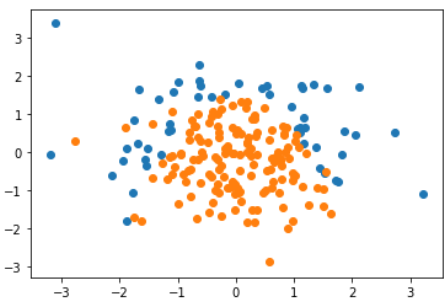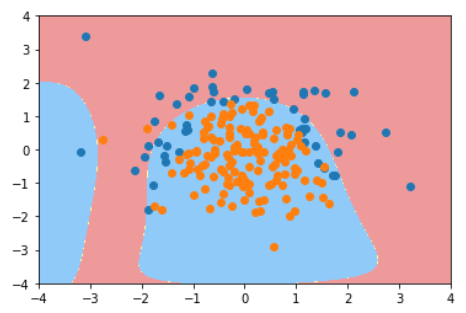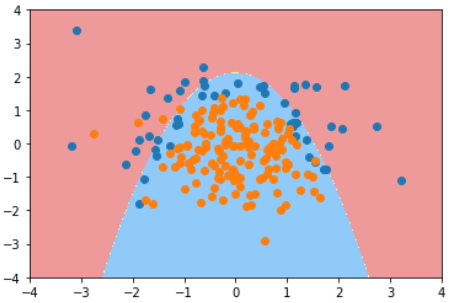在逻辑回归中引入了多项式,模型就会变得复杂,容易出现过拟合。
解决过拟合一个常规的手段就是在模型中添加正则化。
新的目标函数可以是:
J(theta) + a * L2或J(theta) + a * L1,其中a用于表示正则项的重要程度。
但在逻辑回归中,通常这样正则化:
C * J(theata) + L1或C * J(theata) + L2
准备数据
import numpy as np
import matplotlib.pyplot as plt
np.random.seed(666)
X = np.random.normal(0, 1, size=(200,2))
y = np.array(X[:,0]**2 + X[:,1]<1.5, dtype='int')
for _ in range(20):
y[np.random.randint(200)] = 1
plt.scatter(X[y==0,0],X[y==0,1])
plt.scatter(X[y==1,0],X[y==1,1])
plt.show()

使用逻辑回归
from sklearn.linear_model import LogisticRegression
log_reg = LogisticRegression()
log_reg.fit(X_train, y_train)
log_reg.score(X_train, y_train) # 0.79333
log_reg.score(X_test, y_test) # 0.86
plot_decision_boundary(log_reg, [-4, 4, -4, 4]) # 使用8-6中的边界绘制算法
plt.scatter(X[y==0,0],X[y==0,1])
plt.scatter(X[y==1,0],X[y==1,1])
plt.show()

逻辑回归 + 多项式
from sklearn.pipeline import Pipeline
from sklearn.preprocessing import PolynomialFeatures
from sklearn.preprocessing import StandardScaler
from sklearn.linear_model import LogisticRegression
def PolynomialLogisticRegression(degree, C=1.0, penalty='l2'):
return Pipeline([
('poly', PolynomialFeatures(degree=degree)),
('std_scaler', StandardScaler()),
('log_reg', LogisticRegression(C=C, penalty=penalty)) # 遵循sklearn标准构建的类可以无缝结合到管道中
])
使用不同阶数和正则化算法和C值的结果对比
| poly_log_reg.score(X_train, y_train) | poly_log_reg.score(X_test, y_test) | plot_decision_boundary(poly_log_reg, [-4, 4, -4, 4])
--|---|---|--
degree=2 | 0.9133333333333333 | 0.94 | 
degree=20 | 0.94 | 0.92 | 
degree=20, C=0.1 | 0.8533333333333334 | 0.92(泛化能力没有降低) | 
degree=20, C=0.1, penalty='l1' | 0.8266666666666667 | 0.9 | 